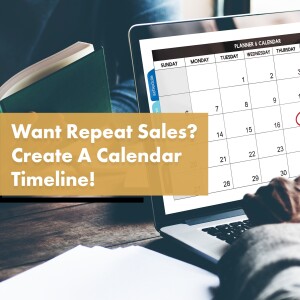Episodes

Wednesday Jan 03, 2024
Calendar Timeline of Communication
Wednesday Jan 03, 2024
Wednesday Jan 03, 2024
In this article, we delve into a powerful strategy to boost your repeat business sales: implementing a well-structured calendar timeline of communication with your database of customers and prospects. By the end of this article, you'll have a comprehensive understanding of how to harness the potential of effective communication to drive growth and revenue.
Understanding the Calendar Timeline of Communication
A "Calendar Timeline of Communication to Your Database" is essentially a structured plan that outlines when and how you'll communicate with the people or customers in your database over a specific period. In simpler terms, it's a schedule that helps you keep in touch with your contacts, whether they are past customers, leads, or subscribers.
Building Meaningful Connections with Your Database
Imagine you have a list of customers' names and contact information in a spreadsheet or a customer relationship management (CRM) system. This list represents your "database." Your goal is to maintain a meaningful and consistent connection with these individuals or groups.
Breaking It Down: Calendar and Communication
The "Calendar Timeline" part refers to setting dates and intervals for your communication efforts. For instance, you might decide to send emails, make phone calls, or post on social media on specific dates throughout the year. These dates are planned in advance and recorded on a calendar.
The "Communication" part means the messages or content you'll share with your database during these scheduled times. It could be anything from newsletters, product updates, promotions, event invitations, or simply staying in touch to maintain a positive relationship.
The Significance of a Calendar Timeline
The importance of having such a calendar timeline is that it helps you stay organized and strategic in your interactions with your audience. It ensures that you don't forget to reach out to them, and it allows you to plan your messages effectively. This strategy will lead to increased retention, loyalty, and result in higher sales.
Crafting Your Calendar Timeline of Communication: A Comprehensive Guide
Now, let's explore a wide range of potential occasions and dates you can incorporate into your Calendar Timeline of Communication:
Holidays: Include major holidays like Christmas and Valentine's Day for sending out greetings, promotions, or special offers.
Seasonal Changes: Announce new collections or updates relevant to changing seasons, like a clothing retailer showcasing spring or winter collections.
Product Launches: Notify your database when you launch new products or services, highlighting features and benefits to generate interest.
Anniversaries: Celebrate your business's anniversary or acknowledge your customers' milestones, providing an opportunity for discounts or promotions.
Birthdays: Send personalized birthday greetings and special discounts, a personal touch appreciated by many.
Events and Webinars: Inform your contacts well in advance about events, workshops, webinars, or seminars, and send reminders as the event date approaches.
Sales and Promotions: Announce sales, discounts, and limited-time offers periodically to create a sense of urgency.
News and Updates: Share important business news, updates, or achievements, such as new hires, awards, or community involvement.
Customer Appreciation Day: Create a special day to show gratitude to your customers, offering them exclusive deals or rewards.
Feedback Requests: After a purchase or service, ask for feedback or reviews from your customers to improve your business and show appreciation for their opinions.
Educational Content: Share helpful tips, articles, or resources related to your industry to establish yourself as an authority in your field.
Customer Milestones: Recognize and celebrate significant milestones in your customers' journey with your business, such as their 1-year anniversary as a customer.
Reorder Reminders: For consumable products, send reminders when it's time for customers to reorder or replenish their supplies.
Follow-Up After Purchase: Enhance the post-purchase experience with follow-up emails or messages to ensure satisfaction and offer support.
Abandoned Cart Recovery: If you have an e-commerce store, send reminders to customers who abandoned their shopping carts, encouraging them to complete their purchases.
Subscription Renewals: For subscription-based services, send reminders about upcoming renewals and the benefits of continuing the subscription.
Customer Surveys: Conduct customer satisfaction surveys periodically to gather feedback and improve your products or services.
Industry-Specific Events: If there are industry-specific events, conferences, or trade shows, inform your audience and offer insights or promotions related to these events.
Implementing Your Calendar Timeline of Communication
Imagine you're the owner of a small coffee shop. To get started, follow these steps:
Step 1: Know Your Audience
Understand your customers, their preferences, and needs. Segment your database based on factors like buying behavior, demographics, and location to tailor your messages effectively.
Step 2: Set Clear Objectives
Define your communication goals, whether it's informing customers about new menu items, promoting special offers, or staying top-of-mind. Knowing your goals will guide your communication efforts.
Step 3: Plan Your Calendar
Create a structured plan outlining when and how you'll communicate with different customer segments. Decide on sending a monthly newsletter, weekly promotions, and special holiday offers, and map it all out on your calendar.
Step 4: Consistency is Key
Maintain consistency in your schedule and messaging tone and branding to build trust among your customers.
Step 5: Personalization
Personalize your messages by addressing customers by their names and tailoring offers to their preferences. This creates a sense of value and appreciation.
Step 6: Use Multiple Channels
Utilize email, social media, SMS, and even direct mail if it suits your audience to reach them effectively.
Step 7: Monitor and Adjust
Keep a close eye on the results of your communication efforts. Monitor how your messages resonate with your audience and whether you observe an increase in sales. Be ready to adjust your calendar and strategy based on the feedback you receive.
Step 8: Utilize the Strategies Checklist
To implement this strategy effectively, take a moment to download our Strategies Checklist. This checklist will be your invaluable companion on your journey to improving your revenue, profit, cash flow, and business value.
Unlocking the Benefits of Your Calendar Timeline of Communication
Now, let's delve into why this calendar timeline of communication is an indispensable asset for your business:
1. Staying Top-of-Mind: Regular and relevant messages keep you top-of-mind with your customers. When they receive your communications, they are more likely to think of your business when they need a product or service you offer.
2. Building Loyalty: Personalizing your messages and offering exclusive deals through your calendar timeline shows customers that you value their business. This builds trust and loyalty, making them more likely to return.
3. Driving Sales: When executed effectively, this communication strategy leads to increased repeat business sales. Customers are more inclined to return to a place where they feel a personal connection.
Taking Action: It's More Than Just Watching
However, the real power of this strategy lies in your active involvement in implementing these steps in your business. Watching this video is just the beginning; you need to pause, think, and take action.
For instance, if you run a hair salon, consider creating a calendar timeline to remind your clients when it's time for their next appointment. Send personalized messages with exclusive discounts to keep them coming back.
If you have an e-commerce store, plan your communication calendar around special events, holidays, and product launches. Utilize multiple channels to reach your customers effectively, and always be ready to adjust your strategy based on the results you observe.
Conclusion: A Strategy for Lasting Relationships and Sales Growth
In conclusion, crafting a calendar timeline of communication with your database is not merely a task; it's a strategy that can significantly impact your business's growth. It's about understanding your customers, setting clear objectives, and consistently reaching out to them in a personalized manner.
Remember, the power of communication lies in its ability to build lasting relationships and drive sales. So, after finishing this article, take a moment to define how you can apply these principles to your business, and watch your repeat business sales soar.
To gain access to strategies specifically made for business owners, visit jetresult.today/get. There's a lot to learn – valuable ideas, energizing live sessions, coaching, and more – all in a community commited to growing revenue, profit, cash flow, business value, and personal lifestyle.
#CalendarTimeline #RepeatBusiness #ImproveSales #GrowRevenue #NicClark#Jetresult


Comments (0)
To leave or reply to comments, please download free Podbean or
No Comments
To leave or reply to comments,
please download free Podbean App.